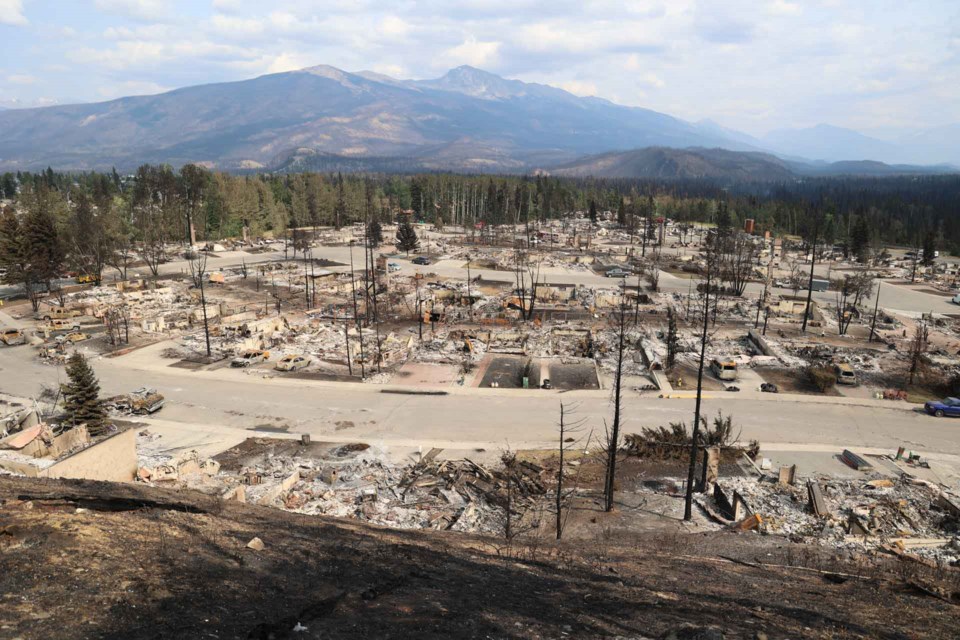Almost a week later, it is difficult to find words to describe the scene in Jasper, after a wildfire decimated the historic mountain community overnight on July 24.
Decimation, devastation, despair—take your pick. It all leads back to a sick sense of longing lingering somewhere in the bottom of your gut.
“My initial response is similar to most of us, I expect… deep sadness,” said Mayor Jack Crompton in a statement to Pique on July 25. “It does make me grateful for the comprehensive emergency planning we have done, and motivates a desire to do even better.”
But there is another word that keeps popping up: inevitable.
I remember reading about the trees turning red in Jasper back in 2018, a result of a bad mountain pine beetle infestation, and thinking it was only a matter of time.
I’ve long thought the same about Whistler—and that was before our own trees started turning red (read more about that on page 13).
For what it’s worth, according to University of Alberta professor Jen Beverley, the dead trees in Jasper were only one small part of the equation.
In an interview with the National Post, Beverley said the dead trees were not as pivotal as the high winds, hot temperatures and overall dry conditions.
“You’re going to get a high-intensity crown fire under those conditions, with or without mountain-pine-beetle kill,” Beverley said, adding trees attacked by mountain pine beetle are most vulnerable to fire a year or so after the fact, before the needles fall and the tree dies.
Even a healthy forest without dead trees would have been consumed by the Jasper fire, which roared into town with a wall of flame 100 metres high, by some estimates.
“When you have extreme wind conditions driving a fire in an area with continuous fuels, there’s very little you can do to stop that,” Beverley said.
The similarities to Whistler’s circumstances are undeniable.
More than 20,000 people in and around the Rocky Mountain town were ordered to evacuate on July 22, three days before the fire arrived. Officials estimate 30 per cent of the town was lost to the fire.
Ron Hallman, president and CEO of Parks Canada, told CTV News the organization started doing prescribed burns in the park in 1995, and started implementing FireSmart measures in 2003.
“To address known threats from mountain pine beetle and other factors, Parks Canada has regularly performed prescribed fires and mechanical removal of hazardous trees and underbrush in the park,” he said.
“Parks Canada and our partners have done everything we reasonably could have done to reduce fire risk over many years, and to be prepared for what may come.”
Jasper’s mayor, Richard Ireland, lost his own home in the fire.
“We anticipated with Parks Canada that something like this could happen. And so we fortified our community. And I credit Parks Canada for the work that they did on the landscape to protect our town and when the attack came,” he told reporters.
“We suffered casualties. Absolutely. And it is so incredibly hurtful. But we did hold our ground, we saved 70 per cent of our town.”
In Whistler, staff at municipal hall watched the disaster in Jasper play out in real-time, “heartbroken” for their local government colleagues and fellow humans across the provincial border.
“It is difficult to watch the footage and hear the stories as Canadians, as citizens of our own resort community, and as local government employees who are responsible for emergency planning in a mountain town. We are balancing shock, empathy and grief with deep professional concern for how we might respond to the same scenario,” a communications official said.
Whistler’s emergency management team, in particular, is tracking everything that’s happening in Jasper.
“There are critical learnings for us as we follow their public alerts, the municipality of Jasper’s emergency notifications and the many news articles being shared,” the official said. “These climate emergencies present opportunities to strengthen our own response.
“Tragedies like this capture everyone’s attention, and we want to ensure our community has the information that they need at their fingertips while it’s top of mind.
“We hope seeing a similar community going through this tragedy is a reminder to Whistlerites that disaster can strike anywhere, and that being prepared can save homes and lives.”
If there’s just one word Whistler should take from the disaster in Jasper, it’s preparedness.
We can’t stop idiots or reckless illegal campers from starting fires; can’t stop the sun from drying out the forests, or lightning striking down; can’t quell the winds that might change our good fortune in an instant.
But we can all be prepared.
Have a go-bag ready and accessible, and make sure it has everything you’ll need if you have to evacuate: clothes, medications, pet food, important documents.
Keep your car’s gas tank full, or close to it (keeping some snacks and water in the trunk doesn’t hurt, either). Don’t have a car? Make sure you know where the closest muster point is in the event of a local evacuation (and pack lightly—there’s gonna be a lot of people on those buses).
Make a plan. Sit down with your family or housemates and talk logistics for when worse comes to worst, and know what you’re going to do in the event of an evacuation.
And most importantly, sign up for Whistler Alert, which will be the fastest way to get immediate emergency updates.
Read more at whistler.ca/emergency.




